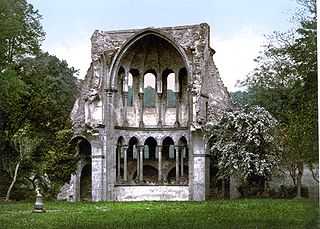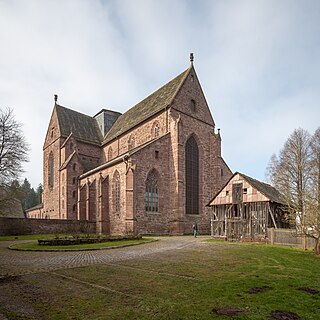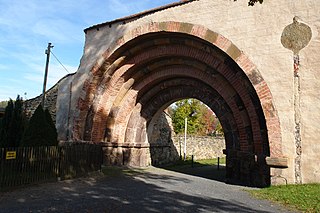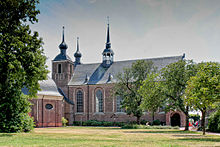
Zirc Abbey, formerly also Zircz Abbey, also known as Zircensis or Boccon, is a Cistercian abbey, situated in Zirc in the Diocese of Veszprém, Hungary.

Grafschaft Abbey is a community of the Sisters of Mercy of Saint Charles Borromeo, formerly a Benedictine monastery, in Schmallenberg-Grafschaft in the Sauerland, North Rhine-Westphalia, Germany.

Aldersbach Abbey is a former Cistercian monastery in the community of Aldersbach in the district of Passau in the valley of the Vils, Lower Bavaria, Germany.

Heisterbach Abbey was a Cistercian monastery in the Siebengebirge near Oberdollendorf in North Rhine-Westphalia, Germany.

Dobrilugk Abbey was a Cistercian monastery in Lower Lusatia in the territory of the present town of Doberlug-Kirchhain, Brandenburg, Germany.

Walkenried Abbey was a Cistercian abbey located in the village of Walkenried in Lower Saxony, Germany. Founded in 1127 on the southern rim of the Harz mountain range, the remnants of the monastic complex since 2010 are part of the Upper Harz Water Regale World Heritage Site.

Schöntal Abbey is a former Cistercian abbey in Schöntal in the district of Hohenlohe, Baden-Württemberg, Germany. It is famous as one of the most impressive pieces of Baroque architecture in northern Württemberg and is now used by the Diocese of Rottenburg-Stuttgart as a retreat and training centre.

Rein Abbey is a Cistercian monastery in Rein near Gratwein, Styria, in Austria. Also known as the "Cradle of Styria", it is the oldest surviving Cistercian community in the world.

Engelszell Abbey was the last Trappist monastery in Austria. It is located near Engelhartszell an der Donau in the Innviertel in Upper Austria.

Amelungsborn Abbey, also Amelunxborn Abbey, is a Lutheran monastery in Lower Saxony, Germany. It is located near Negenborn and Stadtoldendorf, in the Landkreis of Holzminden in the Weserbergland. It was the second oldest Cistercian foundation in Lower Saxony, Germany, after Walkenried Abbey. It survived the Reformation by becoming Lutheran, and with Loccum Abbey, also previously Cistercian, is one of the only two Lutheran monasteries in Germany with an uninterrupted tradition. The abbey church, St. Mary's, is also the parish church of the abbey's former estate villages Negenborn and Holenberg.

Ryd Abbey or Rüde Abbey was a Cistercian monastery in Munkbrarup that formerly occupied the present site of Glücksburg Castle in Glücksburg on the Flensburg Fjord in the Schleswig-Flensburg district of Schleswig-Holstein, Germany.
Michaelstein Abbey is a former Cistercian monastery, now the home of the Stiftung Kloster Michaelstein - Musikinstitut für Aufführungspraxis, near the town of Blankenburg in the Harz in Sachsen-Anhalt, Germany.

Hardehausen Abbey is a former Cistercian monastery located near Warburg in the district of Höxter in the east of North Rhine-Westphalia, Germany.
Bottenbroich Abbey, later Bottenbroich Priory, was a former Cistercian religious house located in Bottenbroich, now in Frechen, about three kilometres north-east of Kerpen, in the present Rhein-Erft-Kreis of North Rhine-Westphalia, Germany.

Altzella Abbey, also Altzelle Abbey, is a former Cistercian monastery near Nossen in Saxony, Germany. The former abbey contains the tombs of the Wettin margraves of Meissen from 1190 to 1381.

Hamborn Abbey is a Premonstratensian monastery in the Alt-Hamborn district of Duisburg, Germany. The abbey is physically located in the diocese of Essen, although not formally part of it.
















